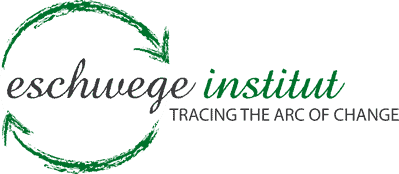
Council is the basic communication practice and part of the stance in Initiatic Process Mentoring®
Council is a non-hierarchical, non-violent and appreciative form of communication that focuses on listening. It is a powerful tool for building sustainable community culture and relationships. Participants sit in a circle around a center and use a “talking piece” to indicate who is speaking.
Council is an expression of an attitude that invites presence and mindfulness in the relationship with oneself, with others and with the environment. It offers teams and groups of all kinds a highly effective means of making their processes sustainable.
The following guidelines apply. These are not rules, but guidelines to use as a guide.
- Stay present.
- Speak from the heart.
- Listen from the heart.
- Be spontaneous.
- Be lean
- Say what serves you as well as the circle and the whole.
- Tell about yourself, not about something or someone.
- Confidentiality: What is said in the circle stays in the circle.
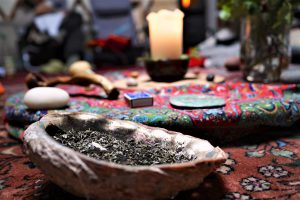 A council has a ceremonial character because of its clear beginning and end and its guidelines. Its archaic form, which is collectively unconscious within us, is easy to remember. Instead of leaders, “facilitators” act, which is derived from the Latin “facilitare” (“make it easy”).
A council has a ceremonial character because of its clear beginning and end and its guidelines. Its archaic form, which is collectively unconscious within us, is easy to remember. Instead of leaders, “facilitators” act, which is derived from the Latin “facilitare” (“make it easy”).
There are a number of different council forms that are used depending on the situation – exchange, conflict exploration, decision-making, planning.
As a basic form of communication, the Council plays an important role in the Initiatic Process Mentoring®. Here the experiences from the intuitive walks and theoretical inputs are further processed and insights gained through emergence that come more from the center shared by all than the ratio.
Council as a basic form is as old as human cultural history. What was the thing with the Teutons and Vikings is the Palaver with the Bushmen of South Africa or the Ho’oponopono with the Hawaiians. The various Indian peoples knew their type of council just as the old Slavic peoples knew their wetsche. Jews know their Chavurah, the Quakers their devout listening, Islam its Sobhet and the Hindus their Satsang.
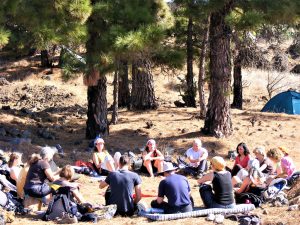 Sitting in a circle around a center and communicating was basically that until the invention of the television set the common form of communication in groups and families. Then the focus of the community shifted from the center to the periphery and the screen. The circle turned into a horseshoe and “far” seeing replaced “near” seeing.
Sitting in a circle around a center and communicating was basically that until the invention of the television set the common form of communication in groups and families. Then the focus of the community shifted from the center to the periphery and the screen. The circle turned into a horseshoe and “far” seeing replaced “near” seeing.
The many thousands of years of cultural experience in this regard have left their mark on our collective unconscious memory, which is why Council basically does not have to be learned, but rather only needs to be remembered. Council is literally in our blood and is therefore easy to convey. In its current form, Council was further developed by the Ojai Foundation in California.
The spirit of the council
A council is a ceremonial space that opens between a clear beginning and a similar end. If possible, a candle is used, with the lighting of which the council can be opened and a dedication can be made. At the end of the council, blowing out the candle concludes the round. Other comparable, simple actions such as opening and reclosing a box are also capable of doing this.
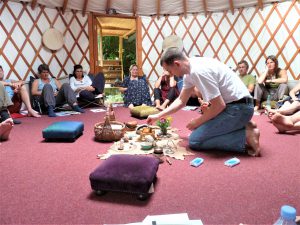 A good council needs an “intent”, an occasion for which one has come together. This can be a topic or an “open council”, in which the point is to invite what spontaneously wants to appear in a circle at the moment. However, the event only acts as a “starter”, because a council must be free from any bias in order to develop its strength. An intent should always be formulated as an invitation to talk about yourself and not to talk about something or someone.
A good council needs an “intent”, an occasion for which one has come together. This can be a topic or an “open council”, in which the point is to invite what spontaneously wants to appear in a circle at the moment. However, the event only acts as a “starter”, because a council must be free from any bias in order to develop its strength. An intent should always be formulated as an invitation to talk about yourself and not to talk about something or someone.
In order to be able to speak of the spirit of the Council, we cannot avoid making use of the significant insight of the Austrian anthropologist and religious philosopher Martin Buber that “I require a Thou to become; becoming I”. When Buber then emphasizes that, from an anthropological point of view, we do not exist at all if such a relationship is not possible for us, he points to an essential phenomenon of our existence that requires presence and relationship. He goes so far as to say: “Only when the ‘Thou’ becomes present does the present arise”.
How true this is can be determined by trying to remember what we did on any day of the week, after a hard week of work in which we switched to “auto-pilot” so to speak and just worked, for example last Wednesday. The bitter truth will not infrequently be that we have no memory of it, and that is because we “didn’t exist” last Wednesday. In a sense, we haven’t even met ourselves. If we remember a moment in the past week, it is because it had to do with an encounter with a real person, a conversation, a cup of coffee with a friend. Here, too, one of the remarkable statements of Martin Buber applies, who says: “All real life is meeting … an encounter with a ‘Thou’ who is present.”
The things we experience, by which we grow, only get meaning when there is a “Thou” who is present with us. What we give each other in the Council is to be this “Thou” for each other. This is how the council becomes a greenhouse or catalyst for personal growth.
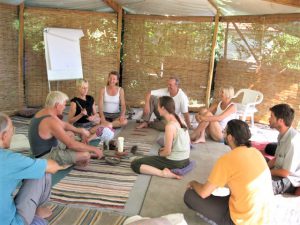 People who live very attentively, especially when supported by certain spiritual practices, can meet themselves in a similar way to create an identity. Ultimately, however, this boils down to an encounter with what Martin Buber calls the “eternal Thou”, in which we participate through our center and by immersing ourselves in our depths.
People who live very attentively, especially when supported by certain spiritual practices, can meet themselves in a similar way to create an identity. Ultimately, however, this boils down to an encounter with what Martin Buber calls the “eternal Thou”, in which we participate through our center and by immersing ourselves in our depths.
In a world in which it is an increasingly rare occurrence when two or more people meet in Buber’s sense, what defines us as human beings withers. In such a world, council events are like waterholes in the desert, like islands in a sea of only functioning. The spirit of the council is invited by its first three guidelines alone to remain present and to listen and speak from the heart.
The intelligence of the heart (le coer, the core) and the midpoint in the council
“When I listen with the heart, I will find meaning. Just as the eye perceives light and the ear perceives sound, the heart is the organ for the sense.”
David Steindl-Rast
Our heart is largely made up of neurons. This can be read very nicely in Stephen Harrod Buhner’s “The Secret Teachings of Plants: The Intelligence of the Heart in the Direct Perception of Nature”. Research such as that of the Institute of Heartmath in California shows that the traditional assumption that the heart is a pump and primarily receives commands from the brain is outdated. Rather, the heart is the conductor in the human organism. Not only via the pressure waves of the blood, but also via nerve impulses, hormones and neurotransmitters produced in the heart as well as through its electromagnetic field, the heart communicates far more with the brain on many levels than the other way around.
In a coherent state, when its rhythm is something like a sine wave, it can affect the brain particularly intensely. The person then feels greater mental clarity, inner calm and is more easily able to make good decisions. Such physiological changes result in a stimulation of the memory and learning centers, in an increased emotional intelligence and in an increased ability to integrate. Our awareness of the feelings and the existence of others is expanded.
The heart seems to function like a transmitter and receiver, it creates its own electromagnetic field that can be measured up to four meters around a person and can certainly be felt much further. It is able to perceive such fields of other hearts and can sense the finest moods in the wide spectrum from affection to aversion or hostility. Thanks to recent research, we now know that the stress reactions that ensure survival (fighting, fleeing, freezing) are only triggered when the heart has perceived a danger via  the cardiac field and reported it to the brain.
the cardiac field and reported it to the brain.
Each person in the Council is a unique circle through this heart field. When we initially check whether we are safe and can trust, this circle is still small. However, as our hearts literally open, this circle widens. If the heart fields of the others also expand, a mandala arises, graphically and seen from above, in which all circles intersect in the middle of the common circle. This creates an intersection, a shared “middle”, the prerequisite for real “sharing”. A German word for such real sharing is “mitteilen” which can be translated as “sharing the middle”.
At this point we should realize that such a heart opening is neither natural nor quick and easy to bring about. It is always the result of a process of mutual trust and trust that needs space and forms that are perceived as secure. Hilde Uden, Holger Heiten’s spiritual teacher, mentioned the metaphor of the trust board in this context. We imagine a seesaw made from a plank or board, similar to the more sophisticated variants on playgrounds. In Hilde’s metaphors, communication is generally propagated horizontally, so that you can only really understand each other at eye level. The two people who want to meet in the middle are initially at the very end of the seesaw and now both have to slowly move towards each other in order to always balance the seesaw in the scales. If one of the two is in too much of a hurry and walks towards the middle with larger steps than the other, the seesaw for the latter will snap down. From now on both talk past each other. Therefore, there needs to be sufficient space for communication, which serves the pure building of trust, before we can communicate via the divided center.
People, depending on the given situation, unconsciously let their hearts and sometimes their heads take over. The practice of the council invites the heart to consciously lead. This is achieved by concentrating on sensual perception, e.g. your own breath or your own weight on the chair, since the heart is also responsible for processing such body perceptions. This makes it easier to be present – one of the guidelines of the council. The present drives away the fear, which likes to deal with yesterday or tomorrow. In the absence of its opponent, there is room for love.
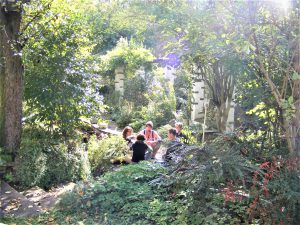 Presence, loving mindfulness for one another, widening heart fields that create space for love and share a common center – all of these seem to be the ingredients that come with the Jesus word “Where two or more in my name (my spirit – the Spirit of love) are together, there I am in the midst of them “could be meant. It is not uncommon for the Council to experience that something like a spirit that gathers everything and organizes everything – one could say a Holy Spirit – emerges from the divided center. Communication that is initially secure becomes true communion.
Presence, loving mindfulness for one another, widening heart fields that create space for love and share a common center – all of these seem to be the ingredients that come with the Jesus word “Where two or more in my name (my spirit – the Spirit of love) are together, there I am in the midst of them “could be meant. It is not uncommon for the Council to experience that something like a spirit that gathers everything and organizes everything – one could say a Holy Spirit – emerges from the divided center. Communication that is initially secure becomes true communion.
The word “emergence” describes the secret of such community processes, in which something unexpectedly new arises.
As a kid, I played on a soccer team. In moments when we were able to let go of our personal, egoistic will and the associated fears in favor of the common, something like team spirit took over. Suddenly we were acting like one body with a mind that knew exactly what its parts were doing and that was perfectly choreographing our actions.
In this sense, Martin Buber’s statement that “Extended, the lines of relationship intersect in the eternal You.” intersect could also be applied to the divided center towards which the participants in a council align.
In this way, the Council becomes a place that can hold “not knowing” in a special way. Not knowing is a condition that is far too little appreciated in our culture. With our knowledge we try to control our life and often even “life”. Our subconscious always thinks it knows in advance what is coming or how it will be in order to protect us from possible dangers. So we are through and through controlled beings who perceive a corresponding reality. For the ego-driven and subconscious forces in us, the state of not knowing is therefore a horror.
This fact will be one of the reasons why, for example, the global crisis triggered by the corona virus, which can also be understood as a control crisis, was perceived as particularly threatening.
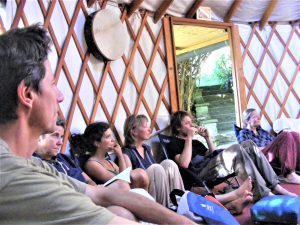 Only being in a state of “not knowing” allows us to be in the now and here and to allow emergent processes. Only when we admit that we do not know can we also allow content, solutions and connections to emerge that we did not yet know existed or that they could be possible. The Council can thus become a co-creative place of dialogue with the “holy” spirit that gathers us in the middle, which comes about indirectly through the communication between the participants – if they are willing to dwell together in a state of not knowing. Stories told in this way in the Council have the potential to weave a newest reality. Council becomes the loom of an inspired new shared story.
Only being in a state of “not knowing” allows us to be in the now and here and to allow emergent processes. Only when we admit that we do not know can we also allow content, solutions and connections to emerge that we did not yet know existed or that they could be possible. The Council can thus become a co-creative place of dialogue with the “holy” spirit that gathers us in the middle, which comes about indirectly through the communication between the participants – if they are willing to dwell together in a state of not knowing. Stories told in this way in the Council have the potential to weave a newest reality. Council becomes the loom of an inspired new shared story.
As described in the U-Theory by Otto Scharmer (author and senior lecturer at the Massachusetts Institute of Technology), the Council enables space for in-depth research into the deeper causes of a problem.
Such research can, according to Scharmer, lead to letting go. That requires trust in something that takes over when we put our best and well-intentioned solution proposal, i.e. our personal will, on hold for a moment – like I did with football.
In a present attitude it becomes possible to let things come and to experience how the best ideas and solutions that were previously inconceivable suddenly crystallize in the middle. In Scharmer’s words, they come from a source of deeper inspiration. In Rilke’s words, it is the ball that an eternal teammate throws us and that does not correspond to the self-thrown again. Solutions that include this source in their development are usually more sustainable. It turns out that nobody and nothing is as smart as all of us together.
Emergence processes cannot be forced. They are very sensitive to any kind of pressure. But when they can develop, they develop great strength. That is why Council has subversive explosive power. Wherever it is introduced, it undermines traditional hierarchical structures and the perfidious working mechanisms of a culture based on competition and fear. Council belongs to the utopia of a post-parliamentary society in which individuals or parties no longer assert themselves. The circle itself and its center become that inviting emergence that is greater than the sum of its parts.
In order to enable and maintain a common space in which everything that has been said so far about the spirit of the Council can come about, it needs the guidelines mentioned at the beginning as well as a thorough introduction to the “Way of Council” by well trained facilitators.
This is an excerpt from the book “Trance und Chance” by Holger Heiten, please do not continue to use it without authorization
Recommended book:
Jack Zimmerman & Virginia Coyle, The Way of Council, 388 pages,
BRAMBLE BOOKS, ISBN-10 : 1883647185, ISBN-13 : 978-1883647186
